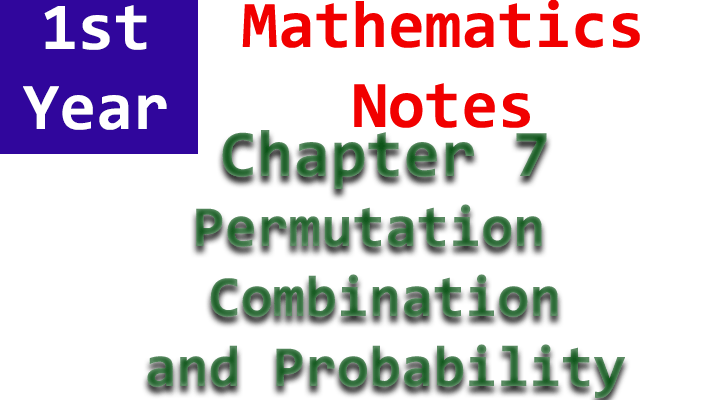Chapter 7 of the F.Sc 1st Year Math curriculum delves into the fundamental concepts of Permutation, Combination, and Probability. This chapter plays a crucial role in building a strong foundation in probability theory and combinatorics, which are essential branches of mathematics with applications in various fields. Permutations explore the arrangement of objects in a specific order, while combinations focus on selecting objects without regard to order. Students will learn how to calculate permutations and combinations in different scenarios, providing them with valuable problem-solving skills.
Furthermore, probability theory introduces students to the concept of uncertainty and randomness, helping them make informed decisions in real-life situations. By studying this chapter, students gain a deeper understanding of how to quantify and analyze uncertainty, making it an integral part of their mathematical knowledge.
Factorial notation, denoted as n!, is a fundamental concept in combinatorics and probability theory. It was introduced by Christian Kramp in 1808 and plays a crucial role in various mathematical calculations, including the computation of binomial coefficients. Let’s delve into factorial notation and understand its significance.
Factorial Notation (n!)
When dealing with a positive integer ‘n,’ the product of all positive integers from ‘n’ down to 1 is represented as ‘n!’ or ‘In’ and is read as “n factorial.” In mathematical terms, it is defined as:
n! = n × (n – 1) × (n – 2) × … × 3 × 2 × 1
To illustrate this concept, let’s consider a few examples:
1! = 1
This is straightforward since there’s only one positive integer less than or equal to 1, which is 1 itself.
2! = 2 × 1 = 2
Here, we multiply 2 by the result of 1! (which is 1).
3! = 3 × 2 × 1 = 6
Similarly, 3! involves multiplying 3 by the result of 2! (which is 2), and so on.
4! = 4 × 3 × 2 × 1 = 24
Extending the pattern, 4! is calculated by multiplying 4 by 3! (which is 6).
5! = 5 × 4 × 3 × 2 × 1 = 120
Continuing the sequence, 5! is obtained by multiplying 5 by 4! (which is 24).
6! = 6 × 5 × 4 × 3 × 2 × 1 = 720
Following the same logic, 6! is computed by multiplying 6 by 5! (which is 120).
General Rule for n!
For a positive integer ‘n,’ factorial ‘n!’ is defined recursively as:
n! = n × (n – 1)!
This recursive definition is vital for the calculation of factorials and simplifies the process. Additionally, it’s essential to note that by convention, ‘0!’ is defined as 1. This may seem counterintuitive at first, but it simplifies many mathematical expressions and ensures consistency in calculations.
Example 1: Evaluate 8! / 6!
Now, let’s apply factorial notation to solve the given expression, which involves division of factorials:
8! / 6!
First, calculate each factorial separately:
8! = 8 × 7 × 6! (using the recursive definition)
6! = 6 × 5 × 4 × 3 × 2 × 1
Now, substitute these values into the expression:
8! / 6! = (8 × 7 × 6!) / (6 × 5 × 4 × 3 × 2 × 1)
Notice that the ‘6!’ terms cancel out in the numerator and denominator, leaving us with:
8! / 6! = (8 × 7) / (5 × 4 × 3 × 2 × 1)
Now, calculate the remaining factors:
8! / 6! = (56) / (120)
Finally, simplify the fraction if necessary:
8! / 6! = 7/15
So, the value of 8! / 6! is 7/15.

